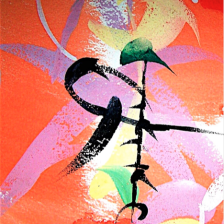![OAHU III. 1968 watercolor on paper [Arches] 26 x 32 in.](https://i0.wp.com/gaborpeterdi.info/wp-content/uploads/2015/07/wc.Oahu-03III1969.jpg?resize=361%2C267)
watercolor on paper [Arches]
26 x 32 in. studio photo
But in 1968, a Peterdi exhibition at the Honolulu Academy of Arts showed only watercolor paintings including OAHU III (above).
Gabor Peterdi’s resplendent watercolor impressions of Hawaii are in the Academy’s upstairs gallery. Their installation without hard-edged traditional mats is a happy one. Line and color now flow easily across the softly irregular edges of hand-pressed paper from one painting to the next. These abstractions of the Islands are excitingly personal, unbrainwashed and unbiased … Though a short-time resident, Peterdi already thinks and feels as a ‘kamaaina’ (‘roots in the soil’). Coming from old lands, he has felt the hard bright newness of this young group of islands … though [the paintings appear] non-objective, their patterns of varied brush-work and colors dancing in inventive textures sing clearly of Hawaii. With every viewing of this show (I’ve been six times and hope to go again before it closes), the vitality of its excitement is always new.
Juliette May Fraser
“Abstractions are Exciting, Personal”
Honolulu Star Bulletin, 26 May 1968

